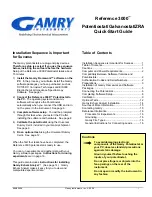
UVX Radiometer
11
output are recessed and should not require attention.
Troubleshooting Procedures
In the event the radiometer malfunctions, the following procedures will enable the user to determine the
source of error and affect repairs.
If, in the following procedures, any of the active circuit elements are replaced, then the calibration
procedure must be performed prior to putting the radiometer back into service.
Troubleshooting Tips
The following paragraphs detail some of the more common malfunctions of the circuit and give the basic
procedures by which the cause of the circuit malfunction can be determined and ultimately corrected.
These procedures are limited to those active elements that can be easily removed and replaced.
Remove the circuit board from the case. Check the battery voltage to make sure it is still above 7.0 volts.
If it is, connect the battery back into the circuit. If it is not, replace it with a new battery.
Note:
In the event any component is removed and replaced as a result of any work done on this unit,
then full calibration procedure must be performed.
•
Display segment does not turn on.
Turn the unit on and observe the display during the first second of operation: i.e. during test
mode. In this case the display should indicate -18:8.8 in the event anyone of the segments of the
display is not turned on, it may indicate that a contact is not making firm contact at the liquid
crystal display.
To correct this, use a pencil tip and place it on the pin contact of the malfunctioning segment.
(Refer to Figure 5 for the display pin-outs) Carefully work the contact pin back and forth with the
pencil tip and watch the segment. Performing this operation will generally correct all display
segment malfunctions.
•
Colon does not turn on
If the colon does not turn on during the test mode, refer to the previous troubleshooting topic. If
the colon does not operate as a result of low battery voltage conditions, then proceed as follows.
Disconnect the battery from the circuit and connect the circuit to a variable 0 to 10 volt DC power
supply. Set the power supply voltage at 9 volts. Turn the power supply on and turn the unit on.
Slowly reduce the output of the DC power supply to 7.0 volts. If the colon does not come on, then
the trimpot RV2 is out of adjustment or the integrated circuit A2 is malfunctioning.
With the power supply set a 7.0 volts, adjust trimpot RV2 fully counterclockwise then fully
clockwise. If the colon does not come on at any time during this adjustment, then the integrated
circuit A2 is malfunctioning. Remove A2 and replace it with a new integrated circuit.
•
Decimal point does not turn on.
Turn the unit on and place the range switch in the position in which the decimal point should be
on. Connect the negative input of the voltmeter to the negative side of the battery.
If the decimal point that should be on is the one corresponding to the 20 uW/cm
2
range, then
connect the positive side of the voltmeter to pin 9 of integrated circuit A2. If the decimal point that
is not on corresponds to the 200 uW/cm
2
range, connect the positive input of the voltmeter to pin
12 of integrated circuit A2.
When the range switch is in the appropriate position for the decimal point to be on, the voltmeter
should read the battery supply voltage; i.e., 9.0 volts. When the range switch is in some other
position, then the voltmeter should read less than 5 volts DC.
Summary of Contents for UVX
Page 4: ...UVX Radiometer 4 Figure 1 Rear and Side Views of Radiometer ...
Page 15: ...UVX Radiometer 15 Figure 4 Calibration Current Source Figure 5 LCD Display Pin outs ...
Page 22: ...UVX Radiometer 22 Figure 13 Typical Output From Low Pressure Mercury Lamp ...
Page 29: ...UVX Radiometer 29 Figure 19 Cosine Response of Typical UVX Sensor Polar Plot ...












































